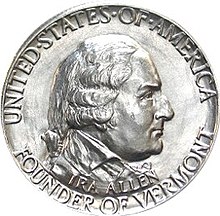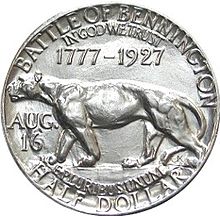United States | |
| Value | 50 cents (0.50 US dollars) |
|---|---|
| Mass | 12.5 g |
| Diameter | 30.61 mm (1.20 in) |
| Thickness | 2.15 mm (0.08 in) |
| Edge | Reeded |
| Composition |
|
| Silver | 0.36169 troy oz |
| Years of minting | 1927 |
| Mintage | 40,034 including 34 pieces for the Assay Commission (11,892 melted) |
| Mint marks | None, all pieces struck at the Philadelphia Mint without mint mark |
| Obverse | |
 | |
| Design | Ira Allen |
| Designer | Charles Keck |
| Design date | 1927 |
| Reverse | |
 | |
| Design | Catamount |
| Designer | Charles Keck |
| Design date | 1927 |
The Vermont Sesquicentennial half dollar, sometimes called the Bennington–Vermont half dollar or the Battle of Bennington Sesquicentennial half dollar, is a commemorative fifty-cent piece struck by the United States Bureau of the Mint in 1927. The coin was designed by Charles Keck, and on its obverse depicts early Vermont leader Ira Allen, brother of Ethan Allen.
On January 9, 1925, Vermont Senator Frank Greene introduced legislation for commemorative coins to mark the 150th anniversary of Vermont declaring itself fully independent in 1777 and of the American victory at the Battle of Bennington the same year. His bill passed the Senate without difficulty, but in the House of Representatives faced an array of problems. Treasury Secretary Andrew W. Mellon sent a letter opposing the bill and dispatched three Treasury officials to testify against it, arguing that the public was being confused as special coin issues entered circulation. The committee's resolve to have no more commemorative coins—after this one—did not impress the full House, which added two more half dollars to the legislation to mark other anniversaries. The Senate agreed to the changes, and President Calvin Coolidge signed the authorizing act on February 24, 1925.
There was a lengthy battle over the design between the Commission of Fine Arts and the Vermont commission in charge of organizing the coin issue, as a result of which the original designer, Sherry Fry, left the project, replaced by Keck. Although the eventual reverse design of a catamount satisfied the Fine Arts Commission, it has been severely criticized by later writers. The coins did not sell out; over a fourth of the issue was returned for redemption and melting. The coins sell for at least in the hundreds of dollars today, depending on condition.